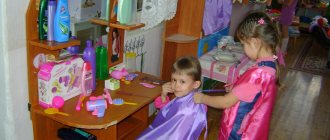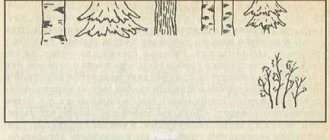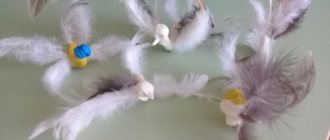Option I
Part No. 1
Select only one and write down its number on the answer form.
- A fungal cell, unlike a bacterial cell, has a) cell walls b) nucleus c) cytoplasm d) vacuole
- The main condition for the habitat of mushrooms is the presence in it of a) water b) minerals c) organic substances d) humus.
- The body of the mushroom, resembling thin white threads, is called a) fruiting body b) mycelium or mycelium c) fungal root d) sporangium
- Cap mushrooms consist of a) a cap b) a stalk c) mycelium d) all answers are correct
- Supplies aspen with water and dissolved substances a) honey fungus b) porcini mushroom c) milk mushroom d) boletus.
- Spoils food a) mucor b) penicillium c) yeast d) pork
- Mushrooms are divided into lamellar and tubular based on a) the structure of the lower layer of the cap b) the structure of the stalk c) the mycelium of the fungus d) the formation of spores.
- Select the number of the picture depicting penicillium.
№1
№2
№3
№4
- What is the name of the organ in which the fungus produces spores? a) mycelium b) sporangium c) stipe (stump) d) mycorrhiza.
Part No. 2
Choose three correct answers out of six.
- Select characteristics common to fungi and plants. a) the cells have a dense shell b) they feed only on ready-made organic substances c) they grow all their lives d) nutrients are absorbed by the entire surface of the mycelium e) the cells do not have pigments f) the cell membranes consist of chitin.
- Select representatives of the symbiont mushrooms a) boletus b) butterfly c) mucor d) russula e) horned mushroom f) boletus
- Choose the names of poisonous mushrooms a) honey fungus b) toadstool c) satanic mushroom d) fly agaric e) champignon f) truffle
Part No. 3
Match the representatives of fungi and the way they feed
A) Boletus B) Honey fungus C) Tinder fungus D) Soil mushroom
1) Saprophyte 2) Parasite 3) Predator 4) Symbiont.
Briefly formulate the rules for collecting mushrooms.
Part No. 4
Complete the sentences with the given words.
- There is a close mutually beneficial relationship between certain types of trees and mushrooms - ...
- At the same time, the threads of the mycelium fly tightly around the root of the tree and even grow into it, forming...
- Through it, the mushroom receives from the tree..., and the tree from the mushroom....
Words to supplement the text: water, mycorrhiza (fungal root), sporangium, organic matter, symbiosis, chitin, smut.
Part No. 5
Name the mushrooms shown in the picture. What group of fungi do they belong to? How are they different from each other? What is their significance in human life?
Solve the situation: while picking mushrooms in the forest, you came across an unknown mushroom. Your actions?
Part No. 6 Practical work
Using a microscope, determine the type of fungus on a microscopic specimen. Tell your teacher the result.
Thematic lesson: Mushrooms
After all our games with mushrooms, you probably already realized that I also couldn’t ignore thematic tasks about mushrooms and prepared them for you. I would also like to draw your attention to something new in the materials posted on all topics “Thematic Lessons”. Now I won’t post how Dima and I play with this or that set - this saves my time and effort, and our classes won’t look like a freeze frame. (This does not apply to our practice Mondays, because it is easier to show than to tell). And in the free time, I can prepare even more interesting materials for you!
And one more joy for mothers - materials will now be in such abundance that you can easily divide them into different ages from 1.5 to 6 years , i.e. you will receive a set of games on this topic not for one year, but immediately for several years!
Many types of tasks are already familiar to you and do not need a detailed description. Such repetition is useful for children, as they unobtrusively practice certain concepts in different forms. And it will be easier for you to understand what needs to be done with this or that benefit. On the blog pages I will list what is included in the kit on this topic, with a short description of why certain tasks are needed and post a link to them. There will also be a detailed description with pictures in the downloadable materials. If you have any questions, I am always ready to answer them.
Lay out a letter and a mushroom - a unique introduction to letters for kids. This is the letter G - the word Mushroom begins with this letter. You can lay it out with buttons or pebbles (sold in pet stores for aquariums).
Lay out the word mushrooms - learning to write - the child lays out a word from individual letters according to the pattern. A similar, but more complicated task is to lay out the names of mushrooms - learning to write - the child lays out words from individual letters according to the pattern.
Complete the drawing - two sheets of tasks - in one to complete the stems of the mushrooms, in the other the caps. Preparing your hand for writing.
Labyrinth - who grows where - Give the children labyrinths and markers - we conduct them and find out under which tree, which mushroom grows. Maze - walk through porcini mushrooms - The child uses a felt-tip pen to trace the path, walking only through porcini mushrooms. Preparing your hand for writing, logic and familiarity with specific mushrooms.
Memory "mushrooms" - All children can play. Print the cards in duplicate. Lay them out in front of the children, ask them to memorize them, then turn all the cards face down. Children must look for identical pairs.
Find the extra – for kids, cut the tasks into separate strips and ask them to find what’s extra in each. Explain your choice if possible. For older children, you can simply offer the whole sheet of paper; their eyes will not run away from the options.
Find the same one - game with clothespins. Offer to find among the three small mushrooms on the cards the same as the big one. And mark the correct answer with a clothespin. Finger motor skills training and development of logical thinking.
Circle the model - development of logic and attentiveness. Use a pencil to trace the mushrooms according to the pattern on the page. Give everyone their own copy.
Fold the halves - cut into separate cards and cut along a wavy line. Invite the children to find halves of mushrooms. This is an entry-level puzzle exercise. Put the puzzles together - cut them into individual cards and cut along wavy lines. Invite the children to put together pictures of mushrooms. (If you have already printed out “fold the halves”, then in a year you can simply cut the same pictures).
Finger gymnastics - Perform the indicated movements of the handles according to the diagram while reading the poem. There are two types of them for babies and older children - different options.
Swipe – kids can be asked to simply run their finger from the mushrooms to the basket. For children who can hold a felt-tip pen in their hands, draw with a felt-tip pen. Wires – connect the mushrooms to the basket. Use felt-tip pens or soft pencils. Watch how children hold a pencil. Preparing your hand for writing.
Arrange according to size and cut out mushrooms. Invite children to lay out from large to small OR from small to large. Sort mushrooms by size - Now let's find large, medium and small mushrooms. Distribute tables and cut cards “Sort by size”.
Color the russulas – Russulas are mushrooms that come in different colors. Color them in the indicated colors. We repeat colors, learn to paint carefully, and prepare our hands for writing.
Add numbers from 1 to 5 from strips - introduction to mathematics - adding a picture - the child remembers the order of the numbers. Fold the stripes from 1 to 10 and from 11 to 20 - a mathematical task - by adding the picture - the child remembers the order of the numbers. Use parts 11 to 20 if children are well developed.
Connect in order - we repeat the ordinal count - connect the mushrooms from 1 to 10 with a pencil. If the children are well prepared, then you can do the second sheet from 11 to 20. Connect - connect the mushroom and its shadow - training your hand for writing and developing logic.
Count and color - the picture shows silhouettes of mushrooms, you need to count how many there are and color the same number of circles. Attention task. Count and connect - count the dots on the fly agaric and connect with the correct number indicating this quantity. Mathematical task and hand preparation for writing.
“Count” cards - Distribute cards to children and ask them to count how many mushrooms are on the cards - mark the correct answers with a clothespin. Select cards in accordance with the preparation of children - to what number they can count. Counting and finger work.
The structure of a mushroom is a task for reading children. A card with a mushroom and separately small cards with the names of its parts. Children must put names on those parts of the mushroom that the arrow shows. You can first discuss what, where and how it is called, and then give the material as independent work to consolidate - lay out the names. There are clue letters in the picture.
Game “Mushrooms” - We listen to poems, answer questions and show how to collect mushrooms.
— Did you walk along the path? — We walked along — and did you find mushrooms? - Found. - One - honey fungus. Two - oil can. Three - wave At the edge. And four is a mushroom. Don't forget to take it. There is russula and saffron milk cap. How much will? - Five and six. _ Here we come to the clearing. The fly agaric and toadstool are here. Maybe we can take them too and put them in a basket?
Creative task - draw white dots on a fly agaric. It is more convenient for kids to draw with a finger or a cotton swab. You can also use the Creative task “Honey Mushrooms” - from the “Autumn Masterpieces” set.
You might be interested in:
Thematic lesson: The sixth day of creation
Thematic lesson: Polar bear cub
Mathematical game "Weather"
Option II
Part No. 1
Select only one and write down its number on the answer form.
- The population of the fungal kingdom is a) 10 thousand species b) 50 thousand species c) 100 thousand species d) 1 million species.
- The fruiting bodies of mushrooms produce a) seeds b) spores c) gametes d) nutrients.
- Select the number of the picture depicting yeast.
№1
№2
№3
№4
- The mycelium in fungi can be a) mononuclear unicellular b) mononuclear multicellular c) multinucleate unicellular d) all answers are correct.
- Unicellular mycelium and spherical sporangia in the fungus a) mucor b) yeast c) penicillium d) smut.
- A person obtains bread, beer, and wine with the help of the fungus a) tinder fungus b) mucor c) penicillium d) yeast.
- is not typical for mushrooms : a) seeds b) spores c) vegetatively (pieces of mycelium) d) sexually.
- Potatoes and tomatoes are parasitized by the fungus a) ergot b) late blight c) smut d) tinder fungus
- An edible mushroom is a) fly agaric b) milk mushroom c) toadstool d) false honey fungus
Part No. 2
Choose three correct answers out of six.
- Select the characteristics common to fungi and animals. a) the cells have a dense shell b) they feed only on ready-made organic substances c) they grow all their lives d) nutrients are absorbed by the entire surface of the mycelium e) the cells do not have pigments f) the cell membranes consist of chitin.
- Select examples of the importance of mushrooms in human life a) cause diseases of the skin, hair, nails b) spoil food c) participate in the formation of humus d) form symbiosis with trees e) participate in the cycle of substances f) are a source of medicinal substances
- Select the names of saprophyte mushrooms a) boletus b) butterfly c) mucor d) russula e) yeast f) boletus
Part No. 3
Match the numbers in the picture with the names of the parts of the mushroom and make labels for the picture. Briefly formulate the rules for collecting mushrooms.
Part No. 4
Complete the sentences with the given words.
- Mycelium penicillium..., in contrast to mucor, which has mycelium....
- Penicillium spores ripen in paniculate spores, and in mucor spores ripen in spherical ones... .
- From penicillium spores, a person receives a medicinal substance that kills bacteria...
Words to supplement the text: mycelium, fungal root, unicellular, multicellular, sporangia, antibiotic, lichen.
Part No. 5
Explain what the picture represents? What type of nutrition does this mushroom belong to? What is formed when mycelium threads sprout from the root of a tree? What does this connection mean for the mushroom and the tree? Solve the situation: for lunch there were boiled mushrooms. Your friend has a stomach ache, has a fever and is feeling nauseous. Your actions?
Part No. 6 Practical work
Using a microscope, determine the type of fungus on a microscopic specimen. Tell your teacher the result.
Report No. 2
The kingdom of living organisms that contain the characteristics of plants and animals.
Common features with plants:
- Pronounced cell wall;
- Immobility during the growing season;
- They reproduce by spores;
- Synthesize vitamins;
- Adsorption during nutrition.
Common features with animals:
- By type of nutrition - heterotrophs;
- The presence of chitin, inherent in arthropods;
- Lack of chloroplasts and photosynthesis;
- Glycogen reserves;
- Formation and release of urea.
The inherent features of fungi give the right to assert that the kingdom of organisms is the most ancient group of eukaryotes, with no direct evolutionary relationship with plants. The emergence of fungi and plants occurred independently of microorganisms whose habitat became the aquatic environment.
Scientists have discovered 100 thousand species, the approximate number of mushrooms is 300 thousand. More than 1000 varieties are discovered annually on the planet. The overwhelming majority of representatives are land dwellers, their habitats are everywhere. Scientists have calculated that 80% of the biomass of the forest floor consists of mushrooms.
Structure.
The vast majority of representatives have mycelium (mycelium), consisting of the thinnest, colorless hyphae, without restrictions in growth and branching.
The mycelium contains:
- Substrate – attachment to the substrate, absorption, transportation of liquid, dissolved substances;
- Aerial - located above the substrate, participates in the formation of reproductive organs.
As adaptive organs, fungi have modifications of the mycelium:
- Sclerotia;
- Stolons (aerial, arched hyphae);
- Rhizoids;
- Rhizomorphs;
- Appressoria (flat thickenings on hyphae);
- Haustoria (parasitic fungi) are presented in the form of mycelial outgrowths.
Reproduction.
- Sexual reproduction is represented in a variety of ways (fusion of cells at the end of hyphae, archegonia, etc.);
- •Asexual – parts of mycelium (individual cells).
Nutrition.
- Saprotrophs – yeasts, cap fungi, molds
- A special feature is the formation of long mycelium.
- Symbionts (parasitism, mutualism).
Varieties of mushrooms.
- Habitat: forest soil rich in humus, fields, meadows, rotting wood (honey mushrooms, oyster mushrooms);
- Poisonous - fly agarics, toadstool, etc.;
- Edible - boletus. Camelina, milk mushroom, boletus, boletus, butterdish, champignon.
- Molds - penicillium. Found on soil and plant products.
Suitable for preparing antibacterial drugs.
- Yeast, reproduction - by budding. Baker's yeast and its varieties - wine, beer, bakery - are applicable for cooking and various drinks.
- Parasites – infect plants, cause crop loss, and cause agricultural damage.
- Powdery mildew - affects rye, wheat and other crops; a white coating appears on the surface of the affected plant, later dark in color.
- Ergots are parasites of cultivated and wild plants.
- Polypores are parasites of the forest; they enter the tree through cracks in the canopy and feed on the tree’s nutrients.
Meaning.
Fungi play an important role in the biosphere. By processing organic compounds into simple ones, they make nutrients available to autotrophic organisms, take an active part in the formation of humus, and clean the environment.
2, 3, 5, 6, 7 grades, the world around us, biology
Answer sheet for the final work “The Kingdom of Mushrooms”. Option I
Last name, first name, ________________________________________________________________________________
Part No. 1 Choose one correct answer out of four (9 points)
| Job number | 1 | 2 | 3 | 4 | 5 | 6 | 7 | 8 | 9 |
| Possible answer |
Part No. 2 Choose three correct answers out of six. (6 points)
| Job number | 1 | 2 | 3 |
| Answer options |
Part No. 3 Match the representatives of fungi and the way they feed. (3 points)
| A | B | IN | G |
Rules for collecting mushrooms_________________________________________________________________________ _________________________________________________________________________________________ _________________________________________________________________________________________
Part No. 4 Complete the sentences with the suggested words. (3 points)
| OFFER No. | 1 | 2 | 3 |
| Missing word |
Part No. 5 Free-response task. (15 points)
_______________________________________________________________________________________
_______________________________________________________________________________________
_______________________________________________________________________________________
_______________________________________________________________________________________
_______________________________________________________________________________________
_______________________________________________________________________________________
Part No. 6 Practical work (5 points)
Score (to be determined by the teacher)______
Evaluation criteria (for self-control):
5 – 42-36 points
4 – 35-30 points
3 – 29-21 points
2 – 20 or less.
Answer sheet for the final work “The Kingdom of Mushrooms”. Option II
Last name, first name, ________________________________________________________________________________
Part No. 1 Choose one correct answer out of four (9 points)
| Job number | 1 | 2 | 3 | 4 | 5 | 6 | 7 | 8 | 9 |
| Possible answer |
Part No. 2 Choose three correct answers out of six. (6 points)
| Job number | 1 | 2 | 3 |
| Answer options |
Part No. 3 Match the numbers in the picture and the names of the parts of the mushroom. (3 points)
| №1 | №2 | №3 | №4 |
Rules for collecting mushrooms_________________________________________________________________________ _________________________________________________________________________________________ _________________________________________________________________________________________
Part No. 4 Complete the sentences with the suggested words . (3 points).
| OFFER No. | 1 | 2 | 3 |
| Missing word |
Part No. 5 Free-response task. (15 points)
_______________________________________________________________________________________
_______________________________________________________________________________________
_______________________________________________________________________________________
_______________________________________________________________________________________
_______________________________________________________________________________________
_______________________________________________________________________________________
Part No. 6 Practical work (5 points)
Score (to be determined by the teacher)______




